I’ve seen a lot of websites. I read a lot of blogs online.
Potentially more than most.
(I host a podcast talking about people’s favourite blogs.)
Some people get this thing right. Most get this wrong. And by most, I mean +96% of sites.
The difference between doing this and not doing this is –
- Ranking content with no links
- Being seen as an authority, not only to Google, but to the majority of your audience
- People bookmarking your site as a permanent resource
- Never running out of ideas
- Compounding growing organic traffic
- Easier and easier rankings
It’s the main difference between a blog doing <1000 views/month and >10,000 views/month.
Stop treating your blog like a magazine
It’s as simple as that.
/roll credits, see you in the next post.
Let’s talk about what that means.
Why you need to run a library and not an editorial
Before I give you the step by step on exactly how to solve this problem, we need to talk about the theory behind this and why sites work like this.
When was the last time you waited for a new post on a blog?
In most cases, never.
People don’t wait. They’re cancelling meetings at 10 am on a Monday morning to make time for your newest release.
Stop thinking like that. It’s not how people work. Don’t let your ego decide when you publish content.
Unless you’re one a small handful of blogs, most people aren’t coming to your site to see what the newest post is. And that’s ok.
The 3 Steps to a Better Blog and More Authority in Your Chosen Niche
There are 3 main concepts you need to understand to do this properly. They’re not difficult. Just somehow everyone seems to let their ego dictate their publish schedule.
Let’s jump in –
Step 1: How do you use the internet?
Step 2: Take this understanding and develop a content model around it
Step 3: Start from the middle and work out with the new model
Below is a breakdown of each of these sections. Taking how people actually use the internet most of the time and developing a content model around that. This content model isn’t new. Many sites use this model to great effect. But most don’t.
Most treat the site as a magazine. Like an editorial. The sooner we get over that way of thinking the better.
Step 1 – How do you use the internet?
A salacious question… I’m not judging.
It usually goes something like this.
- I’m interested in a new topic. Or a new question pops into my head.
- I make a search on this thing. Trying to find an answer to my new interest.
- Clicking into a new site I’ve never been on before I start reading. I’m being introduced to new sub-topics and terminology I’ve never heard before.
- I search these new sub-topics and terms to get a better understanding of them.
- The cycle repeats
- The rabbit hole is endless
- I’ve wasted the last 2 hours Googling why 3 wheeled inline skates are the new hotness, not 4 wheels…
What I found here was I kept seeing the same site or two in each circle deeper I went into the rabbit hole. They’d helped me before, so I clicked on those each time.
I kept going back.
Eventually, I stopped going back to Google and just clicked around one site.
How does my rekindled obsession with foot-based personal transport relate back to not running a blog like a magazine? Great question.
People search for one main thing and go deep on that topic in a short amount of time.
If you don’t have multiple pieces of content on that topic, you’ll lose them. If you even had them in the first place.
The benefits of creating multiple pieces of content about a topic and its sub-topics are compounding.
- It shows authority on that topic.
- If you’ve 4 – 5 pieces on the different facets of an idea/concept/topic, you must know what you’re talking about
- It’s easier to create multiple pieces at once
- Once you’ve done your original research, you can take differing angles on it to create more content. It’s less work for better content.
- It’s a better user experience.
- Going back to the example I shared before. Having more content around the same topic means you have places to direct a new user once they’ve finished reading.
- More internal clicks mean they’re engaged. Better engagement means better rankings. You earn the trust of that user.
- More content around a topic means better rankings on the Search Engine Results Page (SERPs)
- With the increase of voice search and question-based searches – being a niche authority is how you outdo the bigger sites when it comes to ranking.
- Google is much more likely to promote a smaller site with 50 pages on the topic than a huge site with five pages on the topic. As a percentage, the smaller site is the authority here.
Enough with the theory. How do we actually do this in practice?
Step 2 – The Hub and Spoke model of content production
Within each topic we have one hub piece of content, and the rest spoke.
The hub is the big daddy on the topic. It covers everything. There is nothing else on the internet that covers this topic as well as this piece of content.
From this piece, we link to every other piece within our wheel. All the spoke content.
Every time a new spoke is created within this topic, a link is added to the hub content.
Hub Content
A hub piece is a hybrid between a directory/contents page/ultimate guide/introduction. It’s the main place we drive new traffic to for them to dive deeper into the smaller sub-topics we link to.
The rule of thumb I like to use is – When creating the hub content if the overview of a sub-topic takes more than 400 words to discuss, create an introduction to the sub-topic and make it its own page.
This way, we can keep adding to the body of work as a whole and keep the introduction easy and accessible for newer users.
Spoke Content
The sub-topics. Spoke content can be thought of in a number of different ways, for now I’ll give you three different angles you can take to create more spoke content.
- Factual
- Reporting on the facts as they stand. Imagine your hub content is cakes of the world, one of your spoke pieces might be cakes of Europe (dividing by location here), or a cake timeline (dividing by time).
- We’re just taking the main topic and discussing the facts of smaller parts of this topic, but more in-depth
- Opinion
- Spoke content doesn’t have to just be talking about facts, we can discuss our experience within that main topic. This post is an opinion piece on what I think most content marketing teams are doing wrong. It’s based on my experience of reading a lot of blogs, and years of conversations with marketing teams + running experiments on my own sites/clients sites.
- Opinion pieces are – Potentially divisive because you’re making a heavy statement. Back them up with numbers/a report. And step by step instructions to help change the situation for the better
- Reporting
- Go out and report on a topic/sub-topic on behalf of your audience
- Content like this also makes for great links bait due to the unique figures you’re likely to get as a part of your report
- Examples are –
– I watched every Disney movie and this is what I learnt about great story telling
– We spoke to 100 marketing experts over 5 Facegroups. These were the common problems they have
Reporting posts take time, but they show huge authority as a result. They make for great repurposed social content.
Step 3 – How to Make Your First Hub and Spoke Section of Content
There are a number of ways you can make your first hub and spoke cluster on your site.
Here is one of my favourites, it requires no paid tools. Just time and little digging.
Let Google tell you all the spokes
First things first, go throw your main hub keyword into Google and see what you get as the auto-suggest
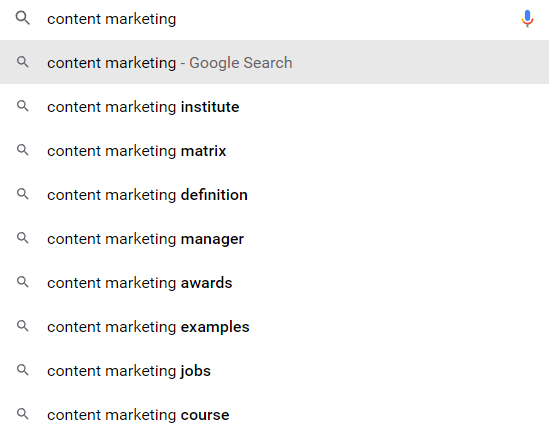
There are a few decent ones here to start my list off with.
- Content marketing definition
- content marketing examples
- content marketing jobs
- I could go on
If you want to go deeper on these, really build out this hub and spoke model, put those spokes into the search again. Essentially we’re after the spokes of the spokes. Meta.
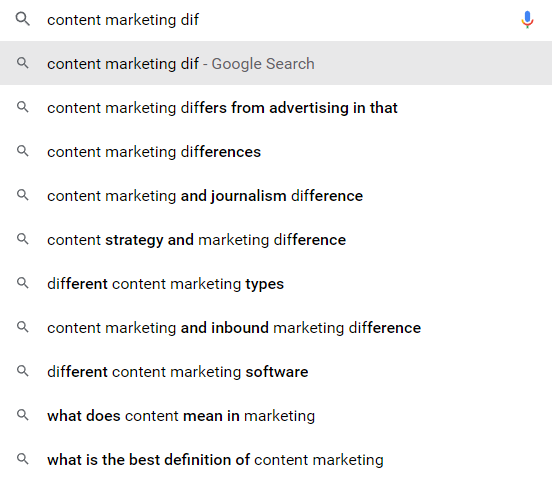
Keep going with this, do it 3-5 times and add anything you like the look of to the list.
The one main thing I will say here is – Add keywords for content you can visualise the end product for. With this being the first hub and spoke model, I want it to be easy. I want you to want to make those pieces.
It shouldn’t be a struggle.
Now we’ve started adding to our list, time to take it a step further.
Stealing is the best form of SEO
Not really stealing, we’re just following SEO rule #1. Becoming the average. Let’s see what other sites are doing.
Go back to your list of keywords you’ve put aside. Start putting them into Google and see who ranks for them.
Do the same few sites keep appearing? This is good news. It likely means they have a little cluster of their own. Sub-topics you see here are ones you should prioritise writing your own hub and spoke.
The next thing we can do is directly look at what these sites are creating when it comes to their hub and spoke models.
Good old Google search parameters.
Let’s take a look at who is ranking for “Content marketing”
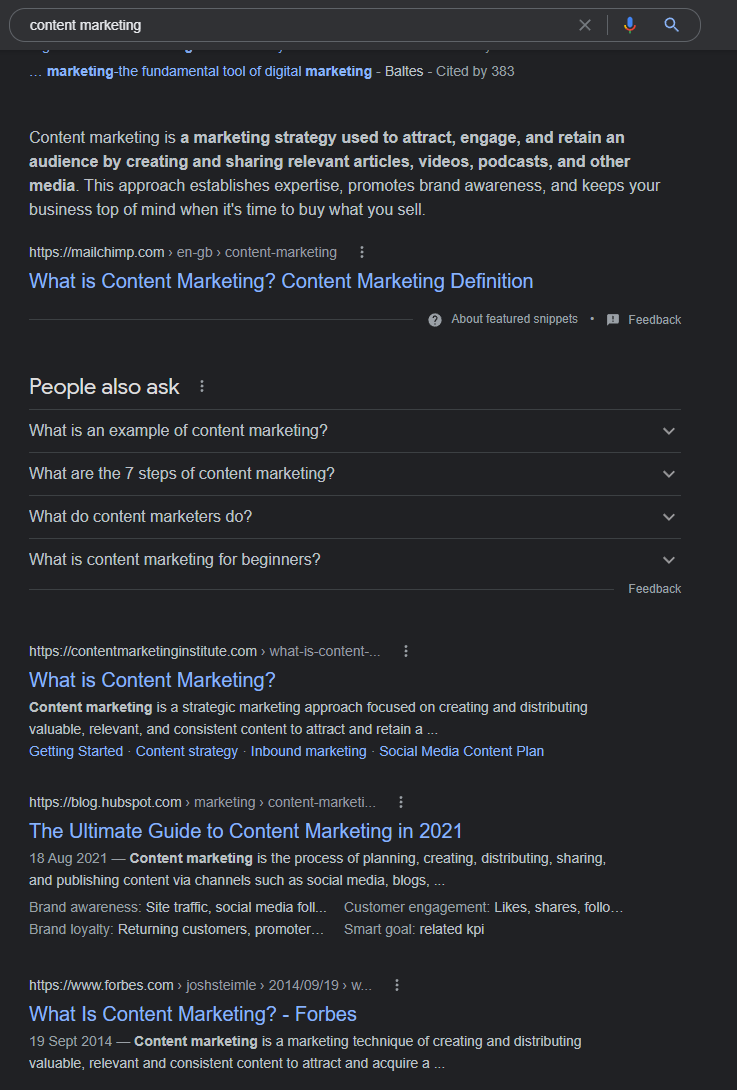
Now what we want to do is refine our search to show only Hubspot, and only URLs with “content marketing” in. That looks something like this.
site:Hubspot.com inurl:"Content-marketing"We end up with a fair bit here – Nearly 8,500 results. So we’ll have to narrow it down a little further. Regardless, this will give us a heap of ideas to write about.
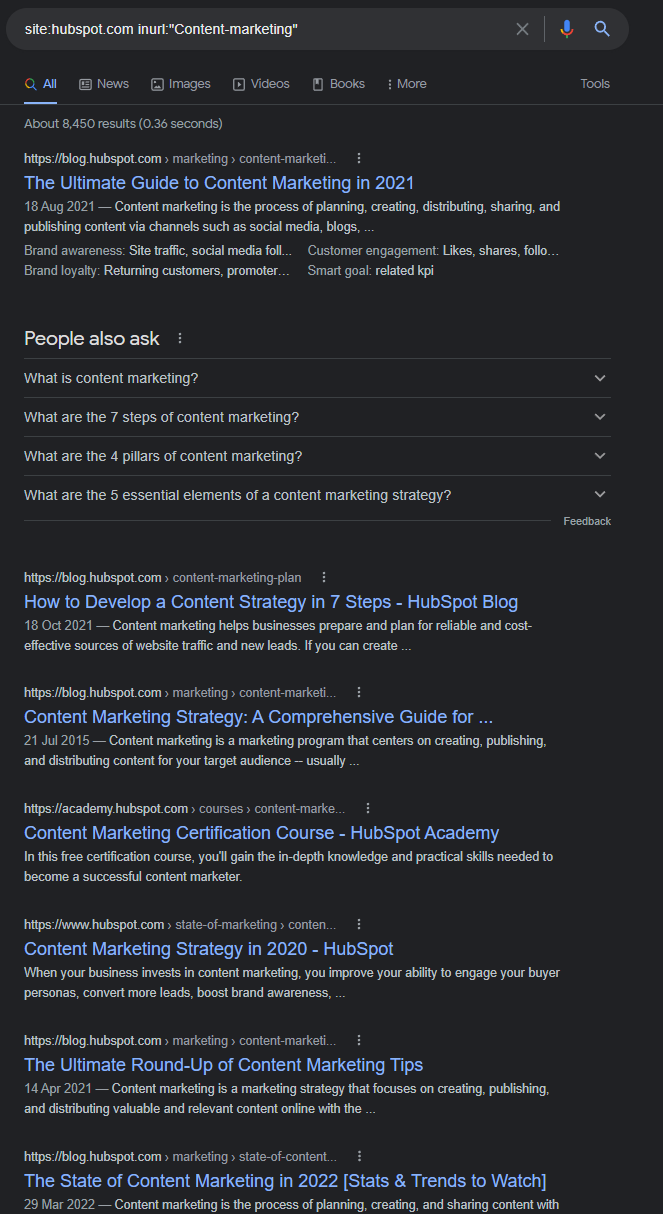
I refined the search one further by restricting the results to just blog.hubspot.com and for the title in the page to contain “Content marketing”.
site:blog.hubspot.com intitle:"Content-marketing"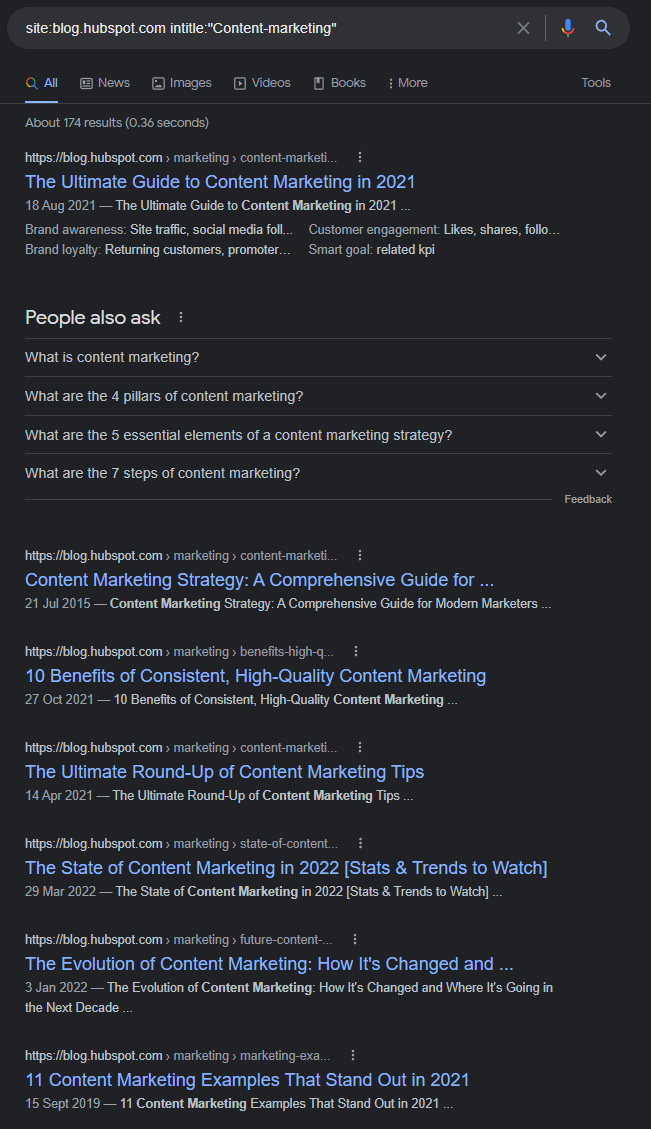
Here we can such ideas as
- Ultimate guide to
- Benefits of
- Round up tips
- How it’s changed – past, present, future
- Examples and ideas
Again, this is an exercise we can do on multiple sites.
Be aware of letting the exercise get in the way of actually making the content. At the end of the day, it’s the published content that get’s traffic. Not the list of ideas on a sticky note.
